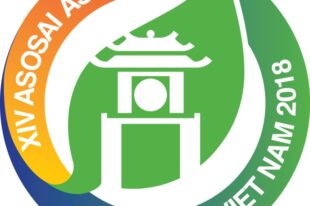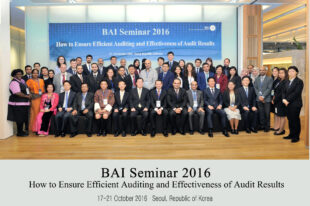Inform, Consult, Involve, Collaborate, Empower
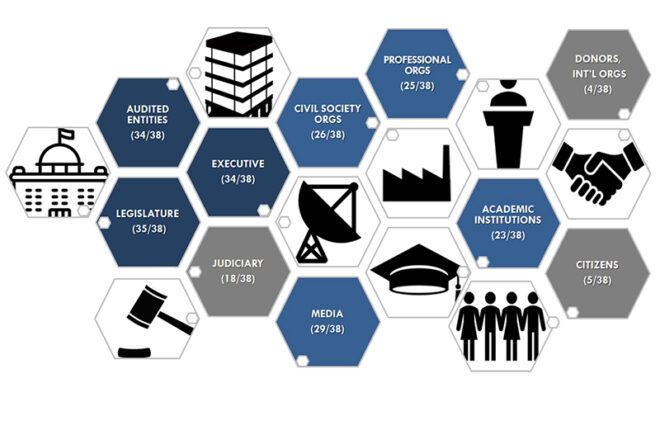
International Survey Uncovers Stakeholder Engagement Definition, Use and Impact
by Eva-Maria Asari, National Audit Office of Estonia
Supreme Audit Institutions (SAIs) play a pivotal role in holding governments accountable for the use of public funds. At the forefront of good governance, SAIs can significantly add value and benefits to the lives of citizens.
This article explores SAI stakeholder engagement and presents findings from an international survey carried out by the National Audit Office of Estonia (NAOE). The NAOE survey, as part of the International Organization of Supreme Audit Institutions (INTOSAI) Development Initiative’s (IDI) SAI Young Leaders project, was distributed to 47 SAIs, as well as the European Court of Auditors. Thirty-eight delegates responded.
Stakeholder Engagement—The Varying Degrees
Stakeholder: a person, group or organization that has interest or concern in the SAI and who can affect (or be affected by) SAI actions.
SAIs have increasingly begun to employ collaborative mechanisms as awareness of the benefits associated with stakeholder engagement has steadily risen.
Stakeholder engagement, as a planned process, gives relevant counterparts an opportunity to provide input into audits. Rooted in a SAI’s culture and historical patterns, the degrees of stakeholder engagement can be viewed as a continuum of potential influence on a decision or action being considered (see Figure 1). At each level, stakeholder participation (and impact) increases.
- Informing and consulting are shaped by one-way communication where stakeholders are passive information receivers. Informing examples include online audit report dissemination, parliamentary committee meetings and media press conferences, while focus groups and feedback surveys are consulting examples.
- Starting with the involvement phase, engagement strategies are based on two-way interaction, which entails providing feedback on stakeholder contribution.
- Collaboration involves developing stakeholder partnerships within the audit process (in parts or whole).
- Empowerment encompasses delegating final decision-making (on identified issues) to stakeholders.
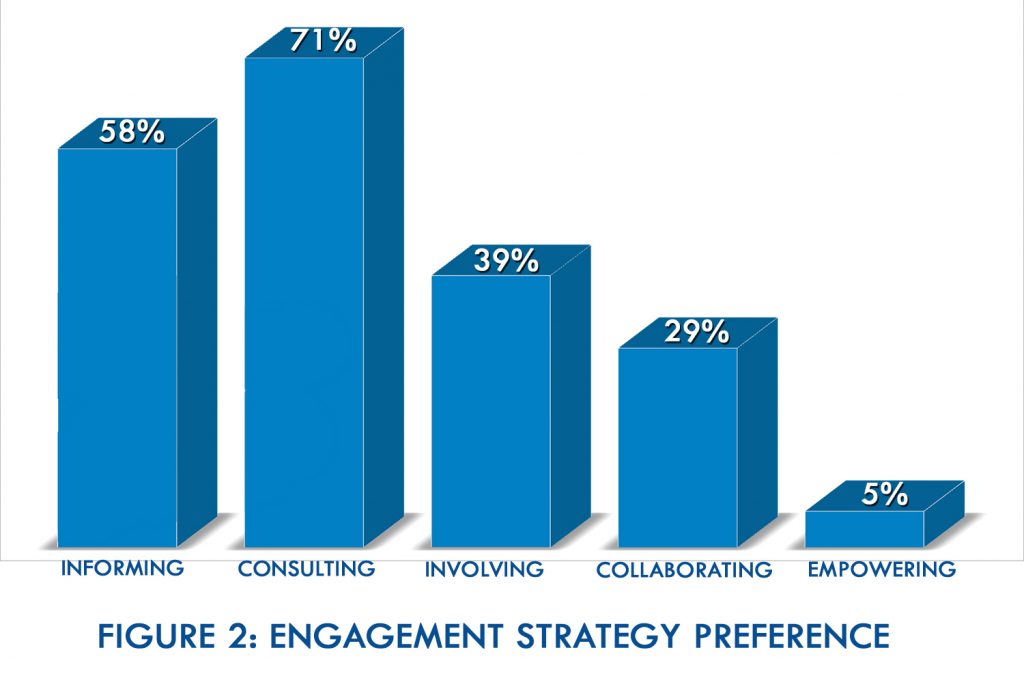 The NAOE survey results showed a majority of respondents preferred engagement strategies primarily based on consultation (see Figure 2), followed by informing and involving. Few SAIs responding to the survey collaborate with stakeholders, and only two SAIs defined stakeholder engagement as empowerment. As SAI engagement interventions vary, differentiating among levels, instruments and stakeholders is essential. The survey allowed for more than one response, and half of the respondents noted employing more than one approach to engage stakeholders.
The NAOE survey results showed a majority of respondents preferred engagement strategies primarily based on consultation (see Figure 2), followed by informing and involving. Few SAIs responding to the survey collaborate with stakeholders, and only two SAIs defined stakeholder engagement as empowerment. As SAI engagement interventions vary, differentiating among levels, instruments and stakeholders is essential. The survey allowed for more than one response, and half of the respondents noted employing more than one approach to engage stakeholders.
Stakeholder Engagement—Impact
Research has shown a strain on stakeholder engagement due to requiring a balance between SAI autonomy and increasing audit impact through meaningful dialogue. At the same time, SAI impact does not depend solely on the degree of independence; capacity to effectively deal with, and establish, functional linkages with the external environment are also crucial.
SAIs, according to survey responses, actively seek ways to engage stakeholders and do so in a more systematic manner. A large majority (80 percent) indicated stakeholder engagement is mentioned in strategic documents and there are guidelines on stakeholder engagement. In addition, more than two-thirds of surveyed SAIs said that they review engagement principles regularly.
However, evaluating engagement activities remains a shortcoming. Though roughly half of the survey’s respondents indicated monitoring stakeholder engagement activities, few performance indicators exist that are connected to stakeholder engagement, which makes it difficult to evaluate activity effectiveness and appropriateness.
Funding is also a challenge, as numerous SAIs responding to the survey reported not having separate positions or funding allocated toward stakeholder engagement activities. Several respondents noted stakeholder engagement is subsumed under other departments (communication teams or senior management). This incorporation limits the availability of information on engagement activity costs, such as staffing hours.
According to IDI’s “Guidance on Supreme Audit Institutions’ Engagement with Stakeholders,” incorporating relevant stakeholders during the entire audit process is vital to an audit report being well-received and achieving greater impact when the report is made public. The earlier stakeholders are included, the greater the impact on the audit, as stakeholder opinions can be taken into account.
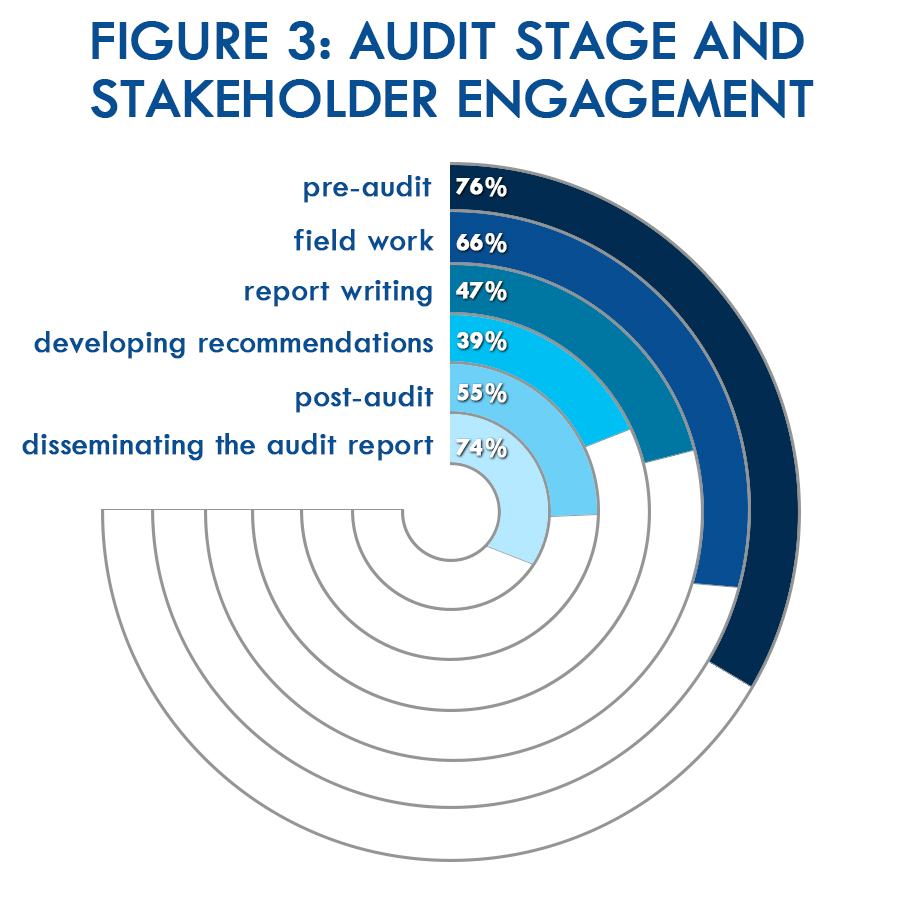 Survey results, which allowed for multiple responses, since SAIs may engage stakeholders in multiple audit stages, foundfrequent engagements before the audit’s start and at the end when disseminating audit report results (see Figure 3). Only two respondent SAIs engage stakeholders solely when disseminating report results, and five SAIs said they engage stakeholders during all audit stages.
Survey results, which allowed for multiple responses, since SAIs may engage stakeholders in multiple audit stages, foundfrequent engagements before the audit’s start and at the end when disseminating audit report results (see Figure 3). Only two respondent SAIs engage stakeholders solely when disseminating report results, and five SAIs said they engage stakeholders during all audit stages.
Identifying key stakeholders also varied according among SAIs responding to the survey (see cover graphic). IDI’s 2018 Global SAI Stocktaking Report noted that legislative and executive branches were, generally, seen as most the most important stakeholders and the groups most consistently engaged. NAOE survey results confirmed the IDI’s findings and revealed only four SAIs prioritize citizens and the wider public, both of which are the least consistently included when it comes to audit recommendation follow-up.
Stakeholder Engagement—A Discussion
The NAOE confirms that those responding to the survey predominantly focus on one-way engagements; however, growing awareness of engagement advantages has resulted in SAIs moving towards more systematic and participatory work with stakeholders and placing increased emphasis on gathering stakeholder feedback.
A majority of survey respondents pointed to seeking stakeholder feedback on audit activities using questionnaires or some means of regular external evaluations. Only three SAIs reported having no formal procedures in place for collecting feedback.
Acting on stakeholder suggestions and including stakeholders in follow-up activities would be the next steps to enhancing stakeholder engagement.
While two SAIs that responded to the survey defined their organizations’ engagements as empowerment, SAIs are not legally able to hand over decision-making authority to stakeholders, thus empowerment is less likely to become the dominant form of SAI engagement any time soon.
Previous research suggests that the approach to performance auditing has shifted. Once a one-off exchange between auditor and auditee, it has become a more continuous dialogue as to assess the entity’s performance and assist and advise on performance improvement.
Societal change cannot be created solely through a SAI and its work. Collaborative support is essential, as stakeholder engagement has the potential to reinforce SAI credibility and the ability to provide objective insight that can add value and benefits to the lives of citizens.
Stakeholder Engagement—Conclusions
Engaging stakeholders throughout the audit process can be challenging. Recently, SAIs have begun to recognize stakeholder engagement as a support instrument that can lead to increased audit impact.
The NAOE survey results demonstrate SAI engagement approaches are becoming more institutionalized and are moving toward participatory involvement—going beyond a simple dissemination of audit results. This includes collecting stakeholder views on audit planning and soliciting feedback throughout the audit cycle.
Monitoring stakeholder activities remains a challenge. Performance indicators can help assess whether the choice of instruments contributes to goal achievement and identifies the benefits associated with engaging stakeholders. Proactive and interactive engagement with stakeholders can enhance audit report impact and help SAIs demonstrate their value to society.
Note: The NAOE distributed the stakeholder engagement survey in March 2018 to 47 SAIs and European Court of Auditors (ECA) as a part of the INTOSAI Development Initiative SAI Young Leader program. 38 responses were received from Argentina, Australia, Bulgaria, Canada, Costa Rica, Croatia, Cyprus, Denmark, Ecuador, Estonia, Finland, Fiji, France, Germany, Greece, Hungary, India, Ireland, Italy, Kazakhstan, Latvia, Liberia, Lithuania, Malta, Mexico, Netherlands, New Zealand, Philippines, Poland, Portugal, Slovakia, Slovenia, Spain, Sweden, South Africa, the United Kingdom, United States, and the ECA.


